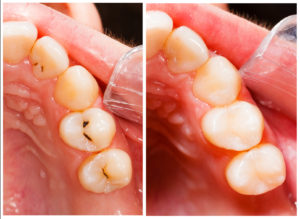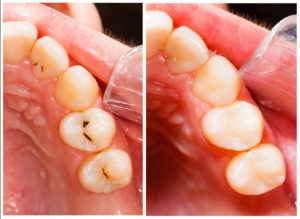
During the time that I was in dental school in the mid-1980’s, the white fillings materials were becoming a popular option for the back teeth. Naturally, silver fillings were more visible and were not as aesthetically pleasing, so patients wanted a tooth-colored option. At first, some dentists used filling materials that were produced for use in the front teeth. Moreover, other dentists purchased the then-newer white composite materials that were stronger and were specifically made for the back teeth.
However, following this time of the mid-1980’s to the 1990’s, many of those white filling materials were found to be inadequate. These materials either broke down too quickly and allowed for recurrent decay, or these materials wore down too quickly, thus reducing their chewing efficiency and perhaps allowing for the adjacent or opposing teeth to move further into the filling material since it was wearing down.
Following the 1990’s, the white filling materials have improved greatly. Some of those initial composite fillings withstood the test of time. However, many of the manufacturers have improved the formulation of their composite fillings to withstand abrasion from chewing and eating, and to allow for more stability of the material itself. As a result of these changes, white fillings have become favored by dentists as well. Things have changed so much that I have not placed a silver filling in over 15 years. This is not to indicate that silver fillings are improper or unsafe; this is to indicate that white fillings are not only better looking, but they also are considered a very reasonable long term option.
With these white fillings becoming the new standard in dentistry, we have found that these fillings take more time to place because they are more technique sensitive than the more traditional silver fillings. Dentists must demonstrate great attention to detail when placing these composite fillings. Should there be any breakdown in the procedure, there is a significantly higher risk of recurrent decay or tooth sensitivity. This is the main downside of white fillings. Given this, if your dentist is indeed attentive and not rushed, this downside is eliminated.
Overall, we do recommend the white fillings for those who have decay and are motivated to care for their teeth. These white fillings may last for a very long time. Further, these fillings are a very adequate replacement for silver fillings when they are not too large. In those cases in which a white filling may become too large, a more durable restoration made of porcelain or gold would be a much better option to enhance longevity and to prevent the potential for more problems.
If you are interested in more of our blog materials, please follow this link.
If you want to know more about Dr. Venincasa and his team, please follow this link.
If you desire a dental appointment, we invite you to contact us at (972) 250-2580.


